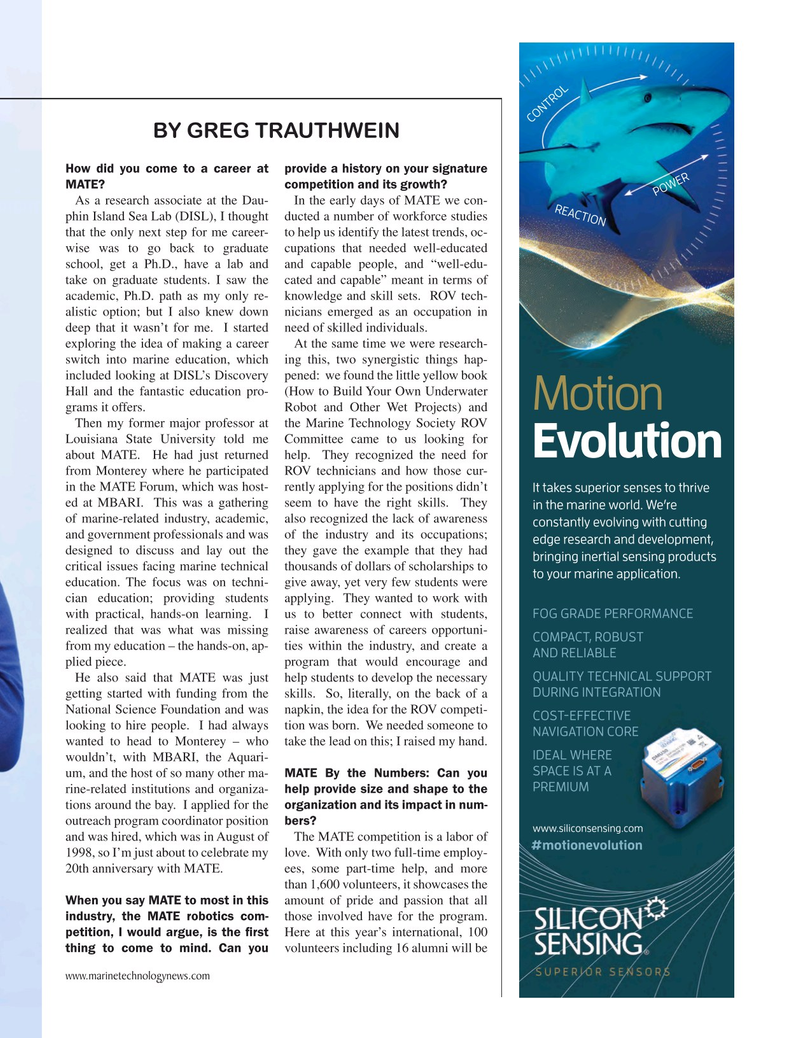
Page 25: of Marine Technology Magazine (September 2018)
Autonomous Vehicle Operations
Read this page in Pdf, Flash or Html5 edition of September 2018 Marine Technology Magazine
BY GREG TRAUTHWEIN
How did you come to a career at provide a history on your signature
MATE? competition and its growth?
As a research associate at the Dau- In the early days of MATE we con- phin Island Sea Lab (DISL), I thought ducted a number of workforce studies that the only next step for me career- to help us identify the latest trends, oc- wise was to go back to graduate cupations that needed well-educated school, get a Ph.D., have a lab and and capable people, and “well-edu- take on graduate students. I saw the cated and capable” meant in terms of academic, Ph.D. path as my only re- knowledge and skill sets. ROV tech- alistic option; but I also knew down nicians emerged as an occupation in deep that it wasn’t for me. I started need of skilled individuals. exploring the idea of making a career At the same time we were research- switch into marine education, which ing this, two synergistic things hap- included looking at DISL’s Discovery pened: we found the little yellow book
Hall and the fantastic education pro- (How to Build Your Own Underwater grams it offers. Robot and Other Wet Projects) and
Then my former major professor at the Marine Technology Society ROV
Louisiana State University told me Committee came to us looking for about MATE. He had just returned help. They recognized the need for from Monterey where he participated ROV technicians and how those cur- in the MATE Forum, which was host- rently applying for the positions didn’t ed at MBARI. This was a gathering seem to have the right skills. They of marine-related industry, academic, also recognized the lack of awareness and government professionals and was of the industry and its occupations; designed to discuss and lay out the they gave the example that they had critical issues facing marine technical thousands of dollars of scholarships to education. The focus was on techni- give away, yet very few students were cian education; providing students applying. They wanted to work with with practical, hands-on learning. I us to better connect with students, realized that was what was missing raise awareness of careers opportuni- from my education – the hands-on, ap- ties within the industry, and create a plied piece. program that would encourage and
He also said that MATE was just help students to develop the necessary getting started with funding from the skills. So, literally, on the back of a
National Science Foundation and was napkin, the idea for the ROV competi- looking to hire people. I had always tion was born. We needed someone to wanted to head to Monterey – who take the lead on this; I raised my hand. wouldn’t, with MBARI, the Aquari- um, and the host of so many other ma- MATE By the Numbers: Can you rine-related institutions and organiza- help provide size and shape to the tions around the bay. I applied for the organization and its impact in num- outreach program coordinator position bers?
and was hired, which was in August of The MATE competition is a labor of 1998, so I’m just about to celebrate my love. With only two full-time employ- 20th anniversary with MATE. ees, some part-time help, and more than 1,600 volunteers, it showcases the
When you say MATE to most in this amount of pride and passion that all industry, the MATE robotics com- those involved have for the program. petition, I would argue, is the ? rst Here at this year’s international, 100 thing to come to mind. Can you volunteers including 16 alumni will be www.marinetechnologynews.com
MTR #7 (18-33).indd 25 MTR #7 (18-33).indd 25 9/6/2018 11:48:50 AM9/6/2018 11:48:50 AM

 24
24

 26
26
